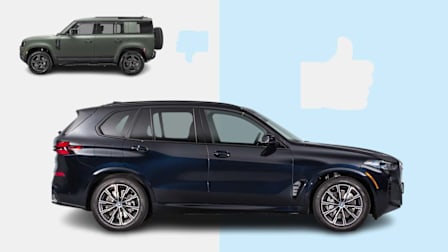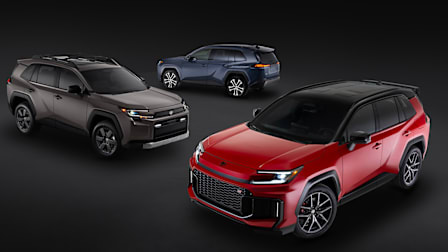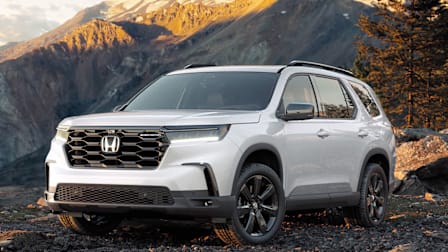First Drive: 2025 Audi Q6 E-Tron Debuts With New EV and Infotainment Technology
It promises competitive range and has an improved regenerative braking system. But the bland interior, stiff ride, and awkward controls detract from the experience.
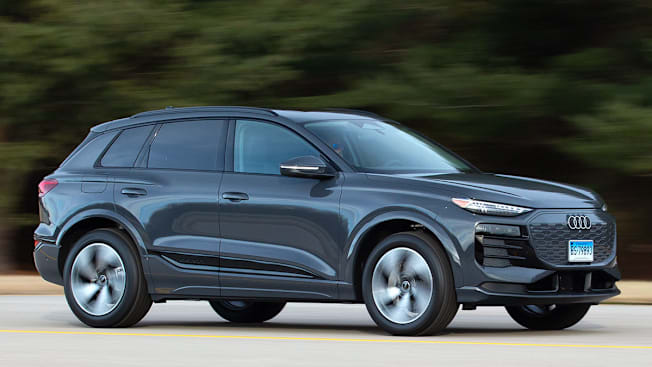
The electric vehicle world seems to be in never-ending turmoil because of tariffs and the threat of tariffs, automakers pulling back on electric vehicle plans, and government incentives potentially being wiped away. Into that chaos Audi has brought us an all-new EV: the 2025 Q6 E-Tron SUV.
Unlike its competitors, such as the BMW iX and Cadillac Lyriq, Audi has given the Q6 more mainstream exterior and interior styling. But that conservative design doesn’t mean the Q6 is outdated on arrival.
This five-passenger SUV is about 4 inches longer, 1 inch wider, and 1.5 inches taller than the gasoline-engined Q5 compact SUV. It’s smaller than the Q8 E-Tron SUV, which uses Audi’s original EV technology and will be discontinued after the 2025 model year.
CR's Take
The new PPE platform gives the Q6 E-Tron a number of improvements over the Q8 E-Tron, let alone the smaller, less expensive Q4 E-Tron. The 800-volt architecture allows for speedy charging on a DC fast charger. An EPA-estimated range of 295 miles (for our version) is far more competitive than the other Audi EVs, and true one-pedal driving at least puts it on a par with competitors. The SUV is pretty quick and very quiet. Inside, passengers are treated to a roomy space with supportive seats and a clear, fast-responding infotainment touchscreen. We like that the SUV comes with a full complement of active safety and driver assistance systems as standard equipment.
But—you knew it was coming—the overall feeling that our testers got during the 2,000-mile break-in period is that the Q6 is “just okay.” Nobody felt blown away by the drab, monochromatic interior. The ride is fairly stiff and is only okay on glass-smooth roads. And the cold weather seems to have a larger impact on driving range than we expected, with some drivers seeing predictions of no more than 226 miles on a full charge—and often much less.
What We Like
Perfectly powerful: With 422 horsepower on tap (456 hp when launch control is engaged), it wouldn’t be out of the question if Audi made the Q6 some super-quick, leap-off-the-line EV. Fortunately, that isn’t the case. Power delivery is more mature and consistent rather than a “grab hold of the reins” experience we’ve seen in a number of high-powered EVs. Yet there’s plenty of surge at any time. Need to pass a slower car on a two-lane road? The Q6 quickly can go from 35 to 55 mph to zip around it. Traveling at above-posted highway speeds and need to jump into a different lane? It’s no problem to quickly boost your speed by 10-20 mph. Is it “thrilling”? No. Is there plenty of always-accessible power? Definitely.
Brakes that feel normal: We’ll let some testers speak for themselves: “The best brake pedal feel of any EV.” “Very well done. Firm with a good bite and easy to modulate.” “I think it’s a positive considering all cars; kudos for an EV.” We’ll leave it at that.
Overall quietness: The Q6 may not mess up the curve for quietness when we test it, but it probably will be toward the head of the class. At speeds below 55 mph, it’s very quiet, with well-sealed doors and windows. We didn’t experience any whining from the electric motors, a problem that plagues some EVs. Wind noise is pretty much muted until you start hitting higher highway speeds, at which point it becomes a bit more noticeable. Road and tire noise stand out on some surfaces, particularly on the highway, where slap from the big 20-inch tires punches through. As one tester said, “You really have little sense of speed based on how quiet [the Q6] is.”
We typically aren’t fans of the fake “driving experience” sounds that come through the infotainment system (which many of us turned off). In addition, the low-speed pedestrian warning sound can be heard inside the cabin, although it’s far less intrusive than in other EVs, such as the ones from GM.
Cabin construction: Audi cabins are often first-rate in terms of how well they’re put together, and the Q6 is no exception. Panel gaps are small and consistent; the few buttons, switches, and latches all have precise action and a solid feel; and the stitching on the seats, doors, steering wheel, and dash is even, without any visible stray threads.
Seat comfort: Another Audi strong point is front seating, and again, the Q6 doesn’t disappoint. The seat cushions are on the firm side, though they still have a plush feel. The bolsters on the backrest and bottom cushion provide just enough body-hugging support for twisty roads without feeling confining. The bottom cushion provides a nice pocket to further hold the occupant in place. A number of testers noted the ability to extend the front of the bottom cushion to provide additional under-leg support. You’ll likely run out of driving range before you become fatigued from the front seats.
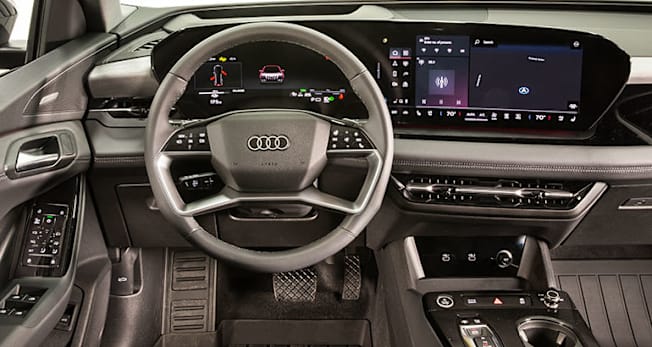
Photo: John Powers/Consumer Reports Photo: John Powers/Consumer Reports
Routine handling/driving: Our Q6 does a good job hiding its 5,430-pound curb weight because it feels quite agile. There’s little body roll and quick turn in response, and the Q6 corners flat. There’s an eager feel when driving it.
Not everything is perfect, as nearly every tester noted that the steering is short on feedback and very light on center. It’s particularly noticeable on the highway, where it needs extra attention and effort to stay in the travel lane.
Coast mode and one-pedal driving: Unlike the Q4 and Q8 EVs, the Q6 has both one-pedal driving capability and a true coast mode. Sliding the gear selector into the B setting engages one-pedal driving, and the Q6 will slow aggressively when you lift off the accelerator pedal and bring the vehicle to a complete stop. The level of regenerative braking in this mode is fixed at 0.25G of deceleration.
When you aren’t in B mode, manual deceleration is engaged using the paddles behind the steering wheel. Level 1 decelerates at 0.06G while Level 2 is stronger, at 0.15G.
Coast mode is engaged when the paddles are first pulled, allowing the Q6 to roll along without any regenerative braking kicking in. This is nice both on the highway and around town and allows the driver to use either the brake pedal or the paddles to slow down.
We also like that the Q6 has a creep feature, which is always active except when in one-pedal mode. This makes the SUV feel more like a conventional gas-engine vehicle with an automatic transmission, as it can slowly pull forward when you lift off the brake pedal, such as waiting in a drive-through line or when yielding at an intersection.
Seat and steering wheel heat: The quick-to-warm seat and steering wheel heaters felt like life-saving features during the multiple weeks of sub-freezing temperatures we faced here in Connecticut. The steering wheel heat is activated through a button on the wheel, while the front seat heaters are activated through the screen. The seat heaters front and rear get hot very quickly and have three levels of warmth.
Driving position: Nearly every tester was able to find a good position behind the steering wheel. The seats and power-adjustable steering column have a wide range of adjustability, so both tall and short drivers were able to place themselves in a position where they could easily reach the controls, see out, and have enough leg, arm, and headroom. The footwell is roomy, with a well-placed left dead pedal, brake pedal, and accelerator pedal. A few testers said that the center console is fairly wide and cut into their right knee room. Others said that the door armrest was fairly far away for their comfort.
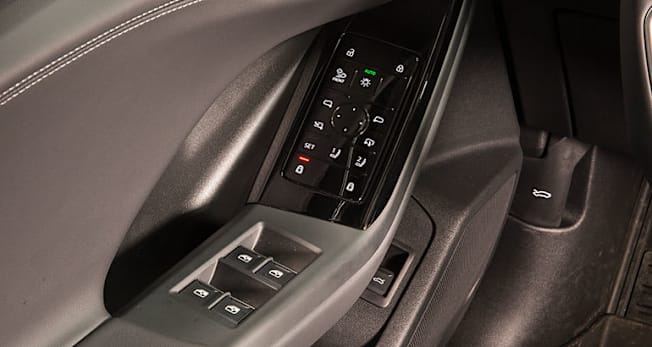
Photo: John Powers/Consumer Reports Photo: John Powers/Consumer Reports
What We Don't Like
Stiff ride: One of the big downsides to the Q6 is ride comfort—or discomfort. It’s simply too stiff for the class and the level of luxury and refinement Audi portrays for it. There are a lot of quick body motions that make it feel quite unsettled. It’s particularly evident because the head-up display image appears to constantly bounce up and down; the SUV has a lot of front-to-rear pitching. The Q6 feels tense and busy at times when you would barely feel anything in other vehicles. Some testers observed that the SUV would harshly crash over some bumps. It’s nowhere near as nice as the ride in the Q8 E-Tron, which has standard air suspension. To add that feature to the Q6, buyers have to move up to the Prestige trim, which is about $7,000 more than the Premium Plus.
Interior letdown: As well-constructed as the interior is, the cabin in our Q6 feels quite dour and plain. Some of this is because the first model we could get our hands on had a black interior. The beige interior is much brighter, and the brown one at least has some contrast.
But it goes beyond the color. Audi seems to have invested heavily in “piano black” trim, while many other automakers are going away from it. This shiny plastic is all over the cabin, including where the optional front passenger display screen would be. The result is a lot of reflection and glare on sunny days, and that trim attracts fingerprints and scratches easily. The front windowsills are hard plastic, which we rarely see in mainstream models, let alone luxury ones. The speaker grilles feel and look inexpensive, as do the plastic air vents on the dash. The top dash pad and trim on the lower dash and doors don’t feel very luxe.
Even the key fob is cheap-feeling black plastic, as if it’s the key from a $22,000 Volkswagen Jetta with Audi rings slapped on. Other late-model Audis, at least, have keys constructed out of that glossy piano black plastic and chrome-look trim. Even though the Q6 has a credit cardlike key that drivers can keep in their wallet, the physical key doesn’t need to be so plain.
Overall, the interior really isn’t exciting and doesn’t feel like one appropriate for a nearly $76,000 SUV.
Touch panel on driver’s door: It’s not noticeable immediately, but the door panels for the driver and front passenger are asymmetrical. That’s because Audi has placed a number of controls on an angled panel under the door handle and in front of the window switches.
In addition to the lock and unlock buttons and mirror controls that typically occupy this space, Audi added seat memory, child lock, and headlight buttons. All are touch-sensitive.
But this pushes the window controls farther back along the armrest, making them awkward to access, particularly if you sit closer to the steering wheel. It’s also too easy to brush against the child lock buttons and accidentally engage them, locking rear-seat passengers in when you arrive at your destination. It’s also easy to fold the side mirrors inadvertently, which at best is a distraction—their motion takes your eye away from the road—and at worst dangerous because they could be folded at the moment you need to use them.
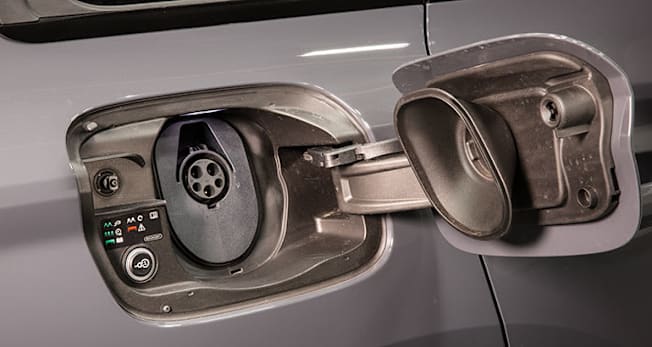
Photo: John Powers/Consumer Reports Photo: John Powers/Consumer Reports
Power-operated charge doors: Audi chose to make the two charge port doors power-operated, as on the Q8 E-Tron. On the one hand, we like that it’s a normal flap, like the ones used on models with a gasoline engine, rather than the Q8’s rectangular port on the left front fender. But like the Q8, the doors are power-actuated. This caused problems during a snow and freezing rain weather event, where the doors iced up and couldn’t be opened. Making them power-actuated doesn’t translate into luxury. Making them easy to operate, like the manual door on the Q4, doesn’t take anything away from the experience.
Interior storage: Audi improved its interior storage space with the Q6, although compared with many recent ICE and EV models, that isn’t a big hurdle. Like other recent Audis, there’s a storage compartment on the lower left side of the dashboard by the driver’s leg. It has a modest opening but is very deep.
Audi also gave the Q6 a decent storage space under the center armrest rather than the tiny phone-sized tray in other Audi models. This space is great for keys, a wallet, sunglasses, and more. But there are two pieces of plastic that hang down toward the front of the space. Ostensibly part of the cup holders, these pieces can’t prevent some items from sliding past and getting stuck behind them. It’s odd that Audi didn’t put a panel in to prevent this from happening.
Up front on the center console, ahead of the two cup holders, is an open storage space and the wireless phone charger. The charger is near-vertical and holds a phone out of sight when not being used. While slick and secure, it’s easy to forget your phone when getting out of the Q6. The problem is made worse by the apparent lack of any audible “you left your phone behind” reminder, which is common in other Audis and Volkswagens. Our $32,811 VW Taos has one! Searching online forums dedicated to E-Trons shows that numerous Q6 owners have found this to be a problem and wonder where the warning is.
Tiny, hidden clock: Come on, Audi. A small clock placed in the upper left-hand corner of the driver’s gauge panel? Yes, there’s the ability to set up a clock on one of the numerous screens in the MMI infotainment system—but still. Just add a permanent digital clock to that 14.5-inch screen in the center. Okay? Thanks.
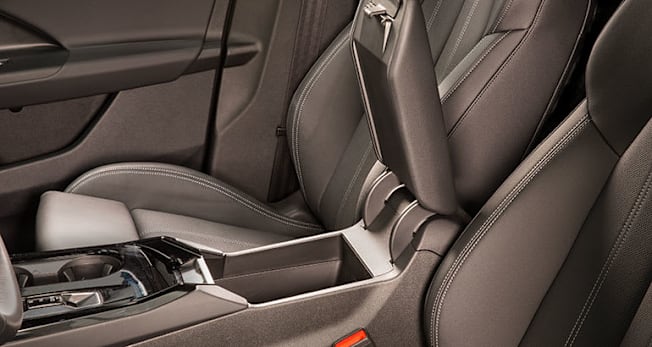
Photo: John Powers/Consumer Reports Photo: John Powers/Consumer Reports
What We'll Keep an Eye On
Infotainment: Audi has used the Q6 to debut its new infotainment system arrangement, which it calls the Digital Stage. It consists of an 11.9-inch display in front of the driver and a 14.5-inch center-mounted touchscreen for infotainment, climate, navigation, and other controls. They’re combined into what looks like a single display screen, with the right side curved toward the driver. There’s also an optional 10.9-inch screen for the front-seat passenger, which we don’t have in our Q6.
The system is overwhelming at first and is one of the few that we have encountered that really requires the dealer to prepare and explain. You need an Audi Connect account just to use it because the “guest” mode limits functionality. Even after spending more than 90 minutes setting the system up, it still required more time for over-the-air updates and settings to adjust. We still have to enter a PIN each time we start the car to use the system.
As with your phone, it’s possible to move the icons for functions and group them into one tile or menu. That way, you can have your most-used features in one place. There’s a left rail with common apps; this, too, can be customized. Functions can be accessed via the app icons, voice commands, or even using handwriting on the screen itself. Suffice it to say that there are numerous ways to navigate through the various functions, but there are so many that it takes a long time to find them.
The Premium Plus trims include the Augmented Reality Head-Up Display, which adds to the business. It’s very detailed but also quite distracting. The following-distance alert is a moving red arrow directly in your line of sight that appears anytime you’re too close to the vehicle in front. The traffic sign recognition is helpful, although the animation has the updated speed limit flying in along the right side of the HUD image and replacing the current sign. Plus, the system will also notify you when approaching an intersection. The only problem is that numerous testers have noticed the speed limit signs are often incorrect, and they sometimes stack up in anticipation of change. Plus, the constant motion takes the driver’s eyes away from focusing on the road. Fortunately, all of this can be disabled.
We like the simple information display on the instrument cluster, but accessing different data via the steering wheel controls isn’t particularly intuitive, even after driving other late-model Audis. But the displays are clear, and Audi uses a simple black background and white coloring for icons and text, which makes for good contrast and ease of reading.
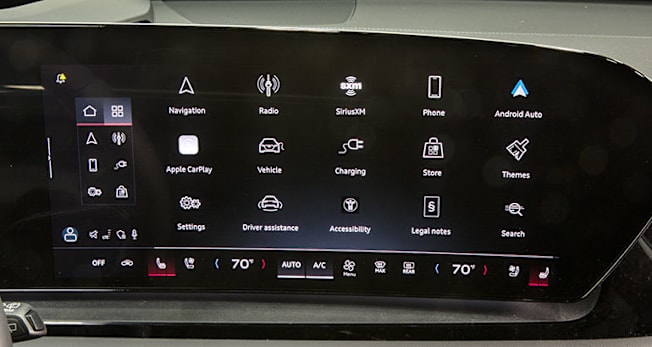
Photo: John Powers/Consumer Reports Photo: John Powers/Consumer Reports
Range: The frigid January and February temperatures that chilled all of us to the bone at our rural Connecticut test center also wreaked havoc on the Q6 E-Tron’s range. Testers reported seeing range estimates of 190 to 226 miles on a full charge, which is significantly below the 295 miles of expected range, according to Audi. Of course, the range decreasing in cold weather is par for the course for any EV. To confirm the numbers, we’ll run the Q6 E-Tron through our range test (as we do with all EVs) later this year to see how it performs in the real world at a continuous 70 mph.
ADAS: Most testers have been positive about the Q6’s driver assistance systems. The adaptive cruise control responds quickly and smoothly when the car in front changes speed. The lane centering system also does a good job keeping the Q6 in its lane, even on sharp curves or taking exit ramps. The HUD has a ton of information, including an icon that shows which nearby vehicles it’s paying attention to when all systems are engaged. But this can get distracting.
Some drivers found the lane centering assistance would fight them to stay in the lane. It would make some odd steering inputs at inopportune times and struggle in construction zones. At other times it would seem to sense a stop sign off of an exit and begin to slow, even though the driver remained on the main road. Both of these situations caused the drivers to lose confidence in the system and drive with it turned off.
We will spend more time evaluating the system on our ADAS Test Loop.
The rear seat: From a comfort standpoint, the rear seat seems to be more good than bad. There’s decent headroom and plenty of foot room under the front seats. Plus, the seats are comfortable, with a firmness like the front seats.
A number of testers noted limited legroom for adults to sit in the back when there are adults up front and said that the door armrests weren’t the same height as the fold-down center armrest, which takes a healthy tug to lower. In addition, while the rear seat is called a three-seater, there’s no chance anyone older than 8 can sit in the middle seat; there’s zero foot room because of the center console that holds the rear-seat climate controls.
Park and charge: Audi has charge ports on both sides of the Q6, like the Q8 E-Tron and Porsche Taycan have. The right side of the car has an AC port, while the left side has the CCS (Combined Charging System) port, which can handle AC and DC fast charging. This gives you more parking options with low-speed chargers, though you may still have to back into a parking space to have the DC fast charging cable reach the port. Opinions are mixed on this arrangement, particularly because Audi’s plans to add a NACS (North American Charging System) port seem to be delayed.
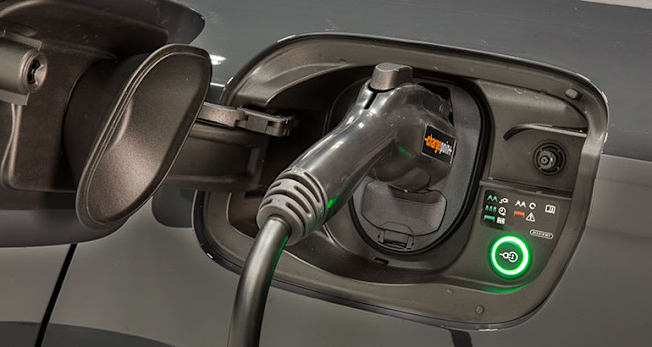
Photo: John Powers/Consumer Reports Photo: John Powers/Consumer Reports
Safety and Driver Assistance Systems
The Q6 E-Tron comes standard with automatic emergency braking, blind spot warning, rear cross traffic warning, lane departure warning, adaptive cruise control, rear parking assistance, and driver attention monitoring. Audi Cruise Assist (part of the Premium Plus package) combines adaptive cruise control and lane keeping assistance, with detailed map data and data collected from other vehicles. It uses radar, cameras, and ultrasonic sensors to maintain the following distance and allow the Q6 to accelerate, decelerate, and stay within the travel lane at both city and highway speeds, including in traffic jams.
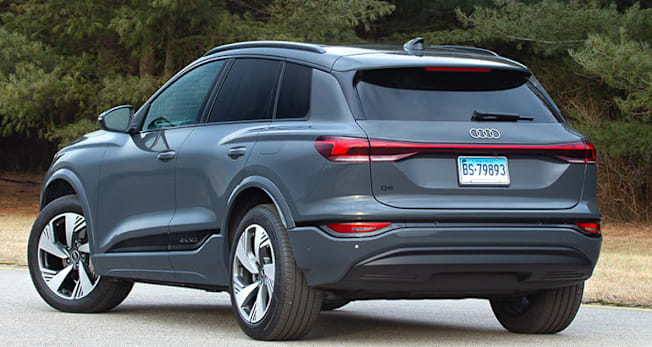
Photo: John Powers/Consumer Reports Photo: John Powers/Consumer Reports


















